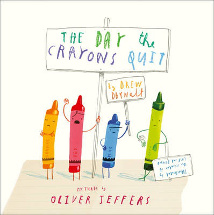The day the crayons quit by Drew Daywalt

Ill. by Oliver Jeffers. HarperCollins Children's Books, 2013. ISBN
9780007513758.
One day, in class, Duncan went to take out his crayons and found a
stack of letters with his name on them. Each letter was from a
different-coloured crayon explaining why they didn't want to work
anymore. Red feels overworked, constantly colouring in fire engines,
apples and strawberries, even working in the holidays colouring
Santas and Valentine hearts. Black is bored with just being used for
outlines and craves things such as black beach balls while poor
peach has had all the paper peeled off and is too embarrassed to
leave the box! So Duncan decides to do something about it . . .and ends
up making all the crayons happy!
The Day the Crayons Quit has consistently appeared on all the
best-reads and must-haves lists that appeared at the end of 2013 and
with good reason. It is delightfully original and has many layers to
it, with each audience being able to take something from it at their
level, whether it be 'What other things could Duncan colour purple?'
to investigating whether it's OK to have an orange whale. I'm very
much reminded of Flowers are
Red by Harry Chapin. There are lessons to be learned
about stereotyping - something we strive to make students aware of
but modern literature doesn't readily allow it because authors
strive to avoid it! You could also use it to explore emotions and
feelings and how we can tactfully express that things are making us
unhappy. So just as the crayons express why they are unhappy,
perhaps this could be a model for each child to express why they are
happy. Because this book has received such acclaim, there are many
suggestions for how it might be used online accessible by a search.
Each letter is written 'by' a crayon using a font that might make
this story difficult for the emerging reader to read alone, but it
is a perfect read-aloud for many ages! Jeffers' illustrations have
an authenticity about them - they look like they have been drawn and
coloured by young children and the credits suggest that there has
been significant input, either physical or intellectual, from them.
And this provides another level to the book - my experience is that
children start to believe that their drawings are not worthy because
they don't have the realism they see around them or the
professionalism of book illustrators, so seeing pictures that look
just like theirs in such a popular book validates their efforts and
hopefully encourages them to keep drawing.
I borrowed this book from my public library because I wanted to see
what the fuss was about, but it is now on my to-buy list so I can
share it with Miss Nearly 3 and Miss 7 because it will appeal to
both. That's the greatest accolade I can offer.
Barbara Braxton